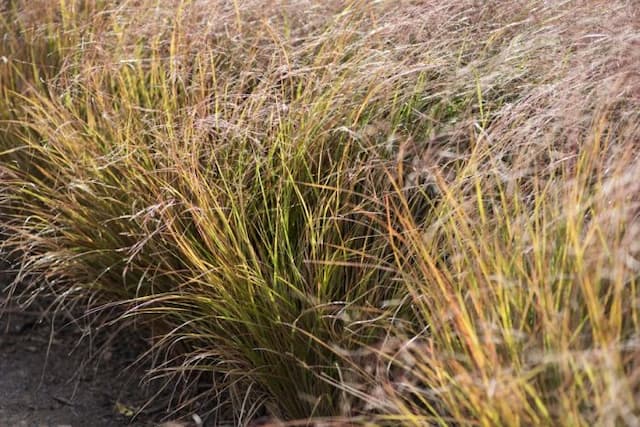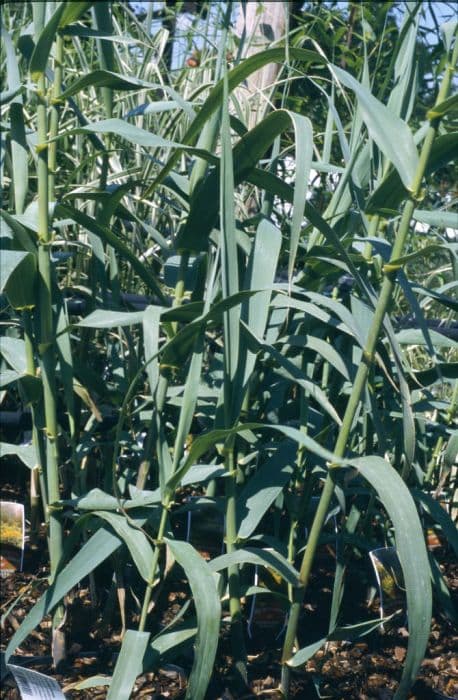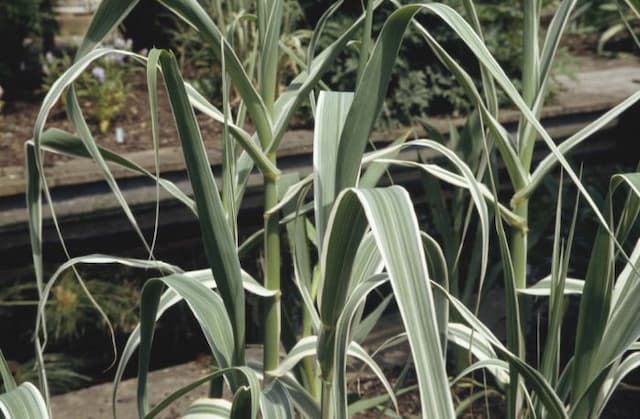Maiden Grass Miscanthus sinensis 'Yaku-jima'










ABOUT
Yaku-jima is a variety of Maiden Grass, which is an ornamental grass with a graceful and upright form. Its foliage consists of fine, narrow leaves that are primarily green but may take on coppery or reddish hues in autumn. This variety is known for being more compact than others, featuring a dense clump of foliage that sways gently in the breeze. In summer, Maiden Grass produces feathery plumes that emerge above the foliage, starting off with a light reddish-brown tint before fading to a soft, silvery white as they mature. These plumes can add a delicate texture to the plant's overall appearance, making it a popular choice in garden designs. The contrast between the soft plumes and the narrow leaves can create a beautiful visual interest throughout different seasons.
About this plant
 Names
NamesSynonyms
Japanese Silver Grass, Maiden Grass, Eulalia, Chinese Silver Grass, Zebra Grass, Porcupine Grass.
Common names
Miscanthus sinensis 'Yaku-jima'.
 Toxicity
ToxicityTo humans
The plant commonly known as Maiden Grass is generally not considered toxic to humans. Ingesting any part of the plant is not known to cause poisoning or serious harm.
To pets
Maiden Grass is also not typically toxic to pets. It does not usually pose a risk of poisoning to animals if ingested, and there are no significant symptoms associated with its consumption.
 Characteristics
CharacteristicsLife cycle
Perennials
Foliage type
Deciduous
Color of leaves
Green
Flower color
Mixed
Height
4 feet (1.2 meters)
Spread
2 feet (0.6 meters)
Plant type
Grass
Hardiness zones
5
Native area
Asia
Benefits
 General Benefits
General Benefits- Ornamental Value: This plant is prized for its fine-textured foliage and graceful, arching form which adds aesthetic value to landscapes.
- Low Maintenance: Once established, it requires minimal care, making it ideal for gardeners who prefer low-maintenance landscapes.
- Drought Tolerance: 'Yaku-jima' is tolerant of dry conditions and can survive with limited water, which is beneficial in regions with water scarcity.
- Erosion Control: Its robust root system helps stabilize soil and prevent erosion, particularly on slopes and in areas prone to soil degradation.
- Seasonal Interest: The plant provides a long season of interest with foliage that changes color in the fall and seed heads that persist into winter.
- Wildlife Habitat: It offers habitat for wildlife, providing shelter and food sources for birds and insects.
- Privacy Screen: Because of its height and dense growth, it can be used as an effective privacy screen or hedge in the landscape.
- Versatility: It is suitable for a variety of landscaping uses, from focal points to mass plantings and can thrive in a range of different soil types.
- Hardiness: This variety is cold-tolerant, enabling it to thrive in cooler climates where other ornamental grasses may not survive.
 Medical Properties
Medical PropertiesThis plant is not used for medical purposes.
 Air-purifying Qualities
Air-purifying QualitiesThis plant is not specifically known for air purifying qualities.
 Other Uses
Other Uses- Erosion Control: Miscanthus sinensis 'Yaku-jima', often referred to as Maiden Grass, is used on hillsides and in landscapes to prevent soil erosion due to its dense root system and foliage.
- Sound Barrier: The dense foliage of Maiden Grass can help dampen noise when planted in thick rows, making it suitable for planting along highways or noisy areas.
- Privacy Screening: Maiden Grass can grow to form dense clumps, making it an effective natural privacy screen for homeowners when planted in a row along property lines.
- Winter Interest: With its tall, dry stalks remaining upright in winter, Maiden Grass can add aesthetic value to gardens during the colder months.
- Craft Materials: The dried plumes and stalks of Maiden Grass are often used in floral arrangements, wreaths, and other craft projects.
- Biodegradable Plant Supports: Gardeners can use the stiff, dried stalks of Maiden Grass as natural plant supports for other, more delicate garden plants.
- Wildlife Habitat: The plant provides shelter and nesting material for birds, as well as a habitat for beneficial insects within the garden ecosystem.
- Fish Ponds: When planted near garden ponds, Maiden Grass can provide shade for fish and help to obscure man-made edges for a more natural look.
- Windbreaks: Tall varieties of Maiden Grass are planted in rows to protect smaller plants from strong winds and reduce wind erosion in exposed areas.
- Themed Gardens: Maiden Grass can be incorporated into Asian-inspired garden designs, contributing to the aesthetic with its upright growth habit and feathery plumes.
Interesting Facts
 Feng Shui
Feng ShuiThe Japanese Silver Grass is not used in Feng Shui practice.
 Zodiac Sign Compitability
Zodiac Sign CompitabilityThe Japanese Silver Grass is not used in astrology practice.
 Plant Symbolism
Plant Symbolism- Resilience: The plant's ability to grow in a range of harsh conditions symbolizes resilience and adaptability to life's challenges.
- Flexibility: Its leaves and stems can bend gracefully in the wind, representing flexibility and the ability to yield without breaking.
- Elegance: With its slender form and feathery plumes, Miscanthus sinensis, commonly known as Maiden Grass, often symbolizes elegance and grace.
- Privacy: Often used in gardens as a screen, Maiden Grass can symbolize the need for privacy or creating boundaries.
- Seasonal Change: It goes through noticeable changes throughout the seasons, symbolizing the cycle of life and the passage of time.
- Growth: It grows rapidly and can reach its full height in one growing season, symbolizing fast and prosperous growth, often related to personal or business endeavors.
 Water
WaterDwarf Maiden Grass requires watering weekly, especially during the first growing season to establish a deep, extensive root system. Once established, reduce frequency, as this plant is relatively drought tolerant. During the peak summer heat, watering with approximately one inch of water once a week is generally sufficient. Ensure the soil is well-draining to prevent root rot. In a garden setting, watering should supplement natural rainfall, not exceed it.
 Light
LightDwarf Maiden Grass thrives in full sun, which means it needs at least six hours of direct sunlight daily. The ideal location would be an open area where it can bask in the sun's rays without being shaded by larger plants or buildings, which ensures the plant's foliage and plumes develop fully and attain their best color.
 Temperature
TemperatureDwarf Maiden Grass is hardy and can withstand temperatures as low as -20°F and as high as 90°F, but it flourishes in temperatures between 50°F and 75°F. This grass prefers warmer climates and typically grows best in USDA hardiness zones 5 through 9, displaying maximum growth when the summer is warm.
 Pruning
PruningDwarf Maiden Grass should be pruned to tidy up the plant and encourage new growth. The best time for pruning is late winter or early spring before new shoots appear. Cut back the entire plant to about 6 inches from the ground annually, which will also remove any dead foliage and improve air circulation.
 Cleaning
CleaningAs needed
 Soil
SoilMaiden Grass prefers well-draining soil, a mix of loam, peat, and sand in equal parts is ideal. Soil pH should be between 5.5 and 7.5. Add organic matter to enrich nutrient content.
 Repotting
RepottingMaiden Grass seldom needs repotting as it thrives outdoors. It's typically divided every 3-4 years to manage its spread rather than repotted.
 Humidity & Misting
Humidity & MistingMaiden Grass tolerates a wide range of humidity levels and does well in average outdoor conditions; indoor specific humidity is not a critical factor.
 Suitable locations
Suitable locationsIndoor
Grow in large containers with ample light.
Outdoor
Full sun, well-draining soil, space clumps 3 feet apart.
Hardiness zone
5-9 USDA
 Life cycle
Life cycleMiscanthus sinensis 'Yaku-jima', commonly known as Dwarf Maiden Grass, begins its life cycle when warm temperatures in late spring trigger germination of its seeds. The plant then enters a rapid vegetative growth phase throughout the summer, forming dense clumps of foliage. By late summer to early autumn, it produces feathery flower plumes that can add visual interest and texture to the landscape. Following flowering, seeds are produced and dispersed, though propagation is more commonly achieved through division. As temperatures drop in autumn, the grass enters a dormant stage, with foliage turning brown and dying back; however, the dried stems can provide winter interest and habitat for wildlife. Come spring, new growth will emerge from the base of the plant, thus repeating the annual cycle.
 Propogation
PropogationPropogation time
Early Spring
Propogation: The most popular method of propagation for Maiden Grass 'Yaku-jima', which is a cultivar of Miscanthus sinensis, is division. This process is ideally done in the late winter to early spring just before the new growth starts. To propagate by division, carefully dig up an established clump of Maiden Grass and use a sharp spade or knife to cut through the root ball, dividing it into smaller sections. Each section should have a good amount of roots and several shoots. After division, the sections can be immediately replanted in a prepared area with well-draining soil, spacing them about 18 inches (approximately 45 centimeters) to give them room to grow. Water the newly planted divisions thoroughly to help establish the roots in their new location. This method of propagation helps to rejuvenate older plants while also producing new plants to expand the garden or share with fellow gardeners.









